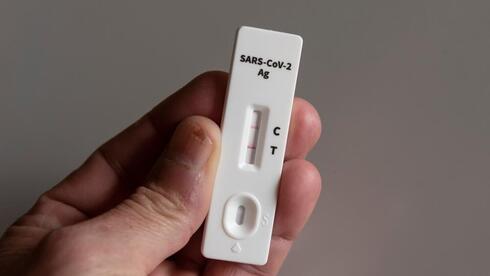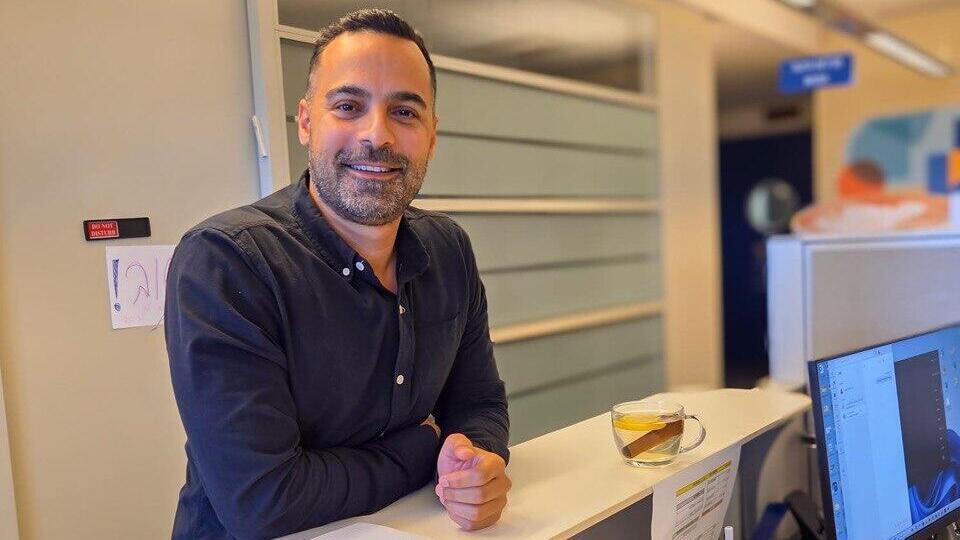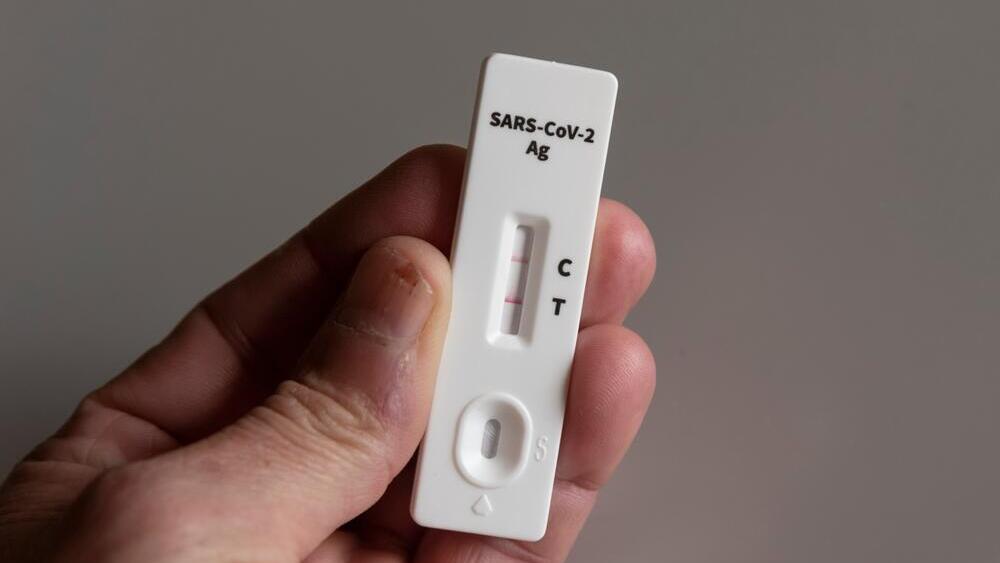“I’m a strong woman, but it just crushed me. I had a very high fever that wouldn’t go down, muscle aches and weakness. I couldn’t get out of bed,” said Dana Gabai, 39, of Ramla, who contracted COVID-19 last month. “I had a headache like I’d never had before, as if my head was swelling to giant proportions.”
Gabai says she had previously taken only one dose of a COVID-19 vaccine. “At the time people were saying these were experimental vaccines and that the long-term effects were unknown, so I decided not to get the follow-up doses,” she said. This was the first time she had COVID-19. “This is not a mild illness at all. I was sure I was going to die. I was in bed for eight days like a corpse.”
Gil Abraham, 42, of Hod Hasharon also caught COVID-19 a few weeks ago and describes a severe, prolonged illness. “I’m vaccinated and this was the third time I got it, and this time it hit me really hard,” he said. “For two days I had a high fever that wouldn’t break, and they called an ambulance because I felt I couldn’t breathe. I had strong heart palpitations and irregular breathing, and I writhed in body pain.”
He said he encountered indifference when he arrived at the hospital. “They closed me behind a curtain. I vomited and felt like I was choking, but the doctor looked at me for a second and just said there was nothing to be done, that it was COVID, that I’d get fluids and painkillers — and sent me home,” he said.
Abraham continued to feel unwell in the days that followed. “My body hurt so much, even the pads of my fingers on my hands and feet,” he said. He also reported loss of taste. “Everything I ate tasted like rust. I lost a lot of weight.” He had difficulty walking even short distances because of breathing problems. He only began to feel better after about 10 days.
“This is not a mild illness, and there isn’t enough awareness that there is a wave of illness,” Abraham said. “I didn’t believe in COVID before. The other times I said, ‘OK, it’s a mild flu,’ but this time it was a level up. I never imagined I’d need an ambulance. I have no underlying conditions. I’m healthy and I exercise.”
Health funds are reporting a rise in cases. Maccabi said its September daily average was 219 diagnosed patients, up from 162 per day in August — an increase of 35%. It said the figures are based on weekdays only and reflect only patients who reported to their family doctor; some patients use at-home tests and do not report results to a physician.
Leumit said cases rose 200% from July to September, with 300 COVID diagnoses in September compared with 100 in July. Clalit said relatively few people report COVID illness to community doctors, but it noted a rise in hospitalizations. Meuhedet reported a 10% increase in patients from August to September and a nearly threefold jump from July to September.
The Health Ministry said there has been a moderation in the increase in COVID hospitalizations. “According to data received from 15 general hospitals, as of mid-September there was about a 10% rise compared with mid-August, versus a 40% rise in the previous month,” the ministry said.
“We’ve seen a slightly more significant wave of COVID-19 over the past three months, and we are now in the midst of that wave,” said Professor Tal Brosh, head of infectious diseases at the Assuta Ashdod public hospital and head of the Health Ministry’s epidemic response team. He sought to reassure the public: “These are not the huge waves we saw in 2021-22 when hundreds of thousands of Israelis were infected one after another and hospital wards filled. Since the start of COVID there has always been ongoing illness, sometimes a bit more and sometimes a bit less. It comes in waves, and most of the time it simply doesn’t interest the public.”
He said the current rise is seen mainly among hospitalized patients, most of them older people with underlying illnesses. “We almost never see hospitalized COVID patients who do not have underlying conditions, and certainly we do not see young people hospitalized with COVID as we did before vaccines, when people in their 40s and 50s were hospitalized with severe COVID,” he said.
Still, he said, deaths are occurring among older people and other at-risk groups. Brosh noted that in 2024 COVID caused more illness and deaths than any other respiratory virus, including influenza. “It’s important to remember that COVID is not a seasonal disease, meaning infections occur throughout the year,” he said.
 Professor Tal Brosh Photo: Private album
Professor Tal Brosh Photo: Private albumAccording to the National Center for Disease Control report for the week ending September 27, the number and percentage of positive COVID samples among hospitalized patients remain high compared with most of the past year. That week reported 92 new cases, about 8.3% of all hospitalized patients in 11 monitored hospitals.
The prominent variants in the current wave are Nimbus (NB.1.8.1) and Stratus (XFG), from the JN.1 lineage, which are also seen globally and have become dominant. Dr. Efrat Wexler, head of primary care at Meuhedet, said the variants appear more transmissible but there is no evidence they are more aggressive.
“We hear from some patients that the illness is worse compared with previous infections, with marked weakness or increased mucus production, cough and runny nose, but we have not found that the current strains produce symptoms unusual beyond what we have known so far — high fever, dry or productive cough, fatigue and weakness, muscle and throat pain, and nasal congestion,” she said.
Brosh said new variants continue to evolve while immunity wanes over time. He noted that most young people were vaccinated with three doses about four years ago. “In those years they may not have encountered the virus, meaning they did not develop infection-derived immunity, and therefore they experience more significant illness.”
Against the backdrop of rising cases, Brosh also pointed to falling COVID vaccination rates in recent years.
“If in 2020-21 Israel was a model for the world and we carried out the fastest, most comprehensive vaccination campaign, in the past year our figures are among the worst in Western countries,” he said. “Last year fewer than 50,000 Israelis were vaccinated, compared with 60%-70% of adults vaccinated in Scandinavia, and even in the United States, despite strong vaccine hesitancy, about 40% of at-risk people were vaccinated, whereas in Israel the figure is almost zero.”
He said the main reason for low vaccination uptake is a lack of public awareness and guidance. “We did a very poor job in the past two years. The Health Ministry and the health funds failed in outreach to at-risk groups about the need to get a COVID vaccine each year, similar to influenza. So even people who see the value in vaccines are not getting vaccinated because they don’t even know they should,” according to Brosh.
He also blamed rising anti-vaccine sentiment — a growing phenomenon in Israel and worldwide, especially regarding COVID vaccines. “During the pandemic many felt the vaccine was imposed on them, and at the same time a lot of misinformation against vaccines spread. I’m convinced that even if we run a very good campaign now, many people will still be afraid to vaccinate, and we must act on this,” he said.
Under updated Health Ministry guidance, COVID vaccination is recommended for people 65 and older and for those 6 months to 64 years who belong to risk groups: people with chronic illnesses including kidney disease, chronic lung disease and heart disease; smokers; and residents of geriatric institutions, nursing homes and assisted living.
Brosh said the updated recommendations align with other countries such as Britain, the United States and the Nordic countries. For people 65 and older who live in geriatric institutions, nursing homes or assisted living, an additional vaccine dose is recommended after six months — effectively two doses a year. Two doses a year are also recommended for people 75 and older regardless of health status. People who are not in risk groups may also be vaccinated if they wish to reduce their risk of infection and illness.
Starting next month, the vaccines available through the health funds will be Novavax — a vaccine that uses the coronavirus spike protein produced in the lab. After injection the body recognizes the protein as foreign and learns to fight it. “This vaccine also underwent scientific trials and is very safe to use,” Brosh said. “There are also financial considerations that shouldn’t be ignored regarding the cost of vaccines and the choice of these vaccines.” The Novavax vaccine is authorized for people 12 and older, which will require the Health Ministry to find solutions for children in at-risk groups.
As last year, the vaccines to be administered target the JN.1 strain, in line with international organizations and the Health Ministry’s advisory committee on infectious diseases and vaccines. “The understanding is that the changes the virus made over the past year are not very dramatic, so it’s likely the vaccines will be effective against the strains currently circulating,” Brosh said.
Wexler summed up: “The coronavirus is not going away soon, and vaccination significantly reduces the risk of severe illness, complications and hospitalization.” She stressed: “Anyone who is sick should avoid going to crowded places and participating in gatherings. That simple step of personal responsibility can reduce many infections.”
First Appeared on
Source link








